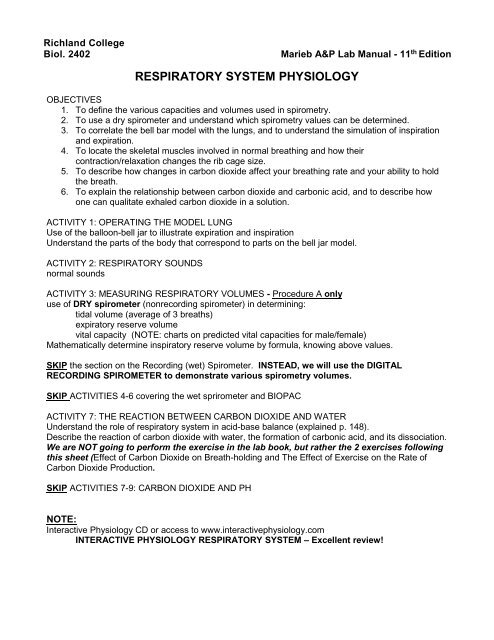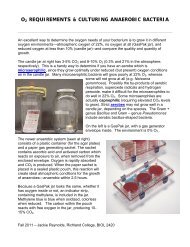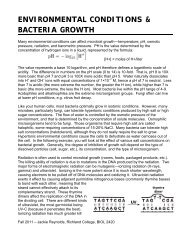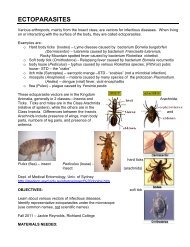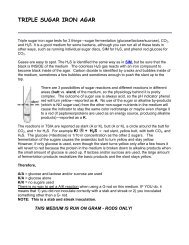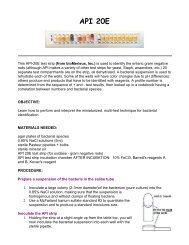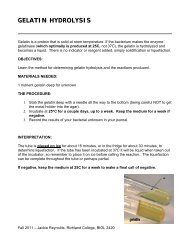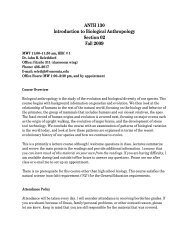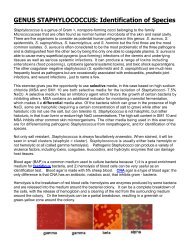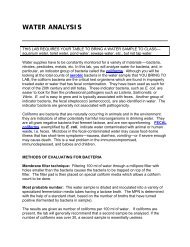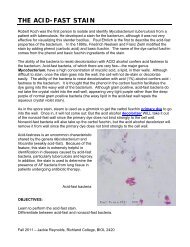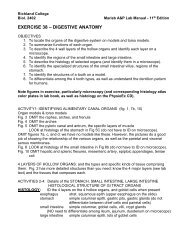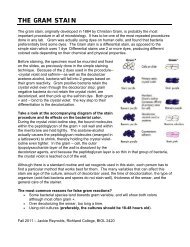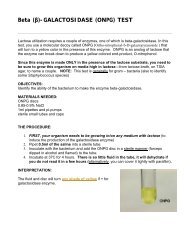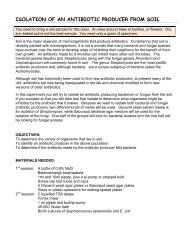RESPIRATORY SYSTEM PHYSIOLOGY
RESPIRATORY SYSTEM PHYSIOLOGY
RESPIRATORY SYSTEM PHYSIOLOGY
Create successful ePaper yourself
Turn your PDF publications into a flip-book with our unique Google optimized e-Paper software.
Richland College<br />
Biol. 2402<br />
Marieb A&P Lab Manual - 11 th Edition<br />
<strong>RESPIRATORY</strong> <strong>SYSTEM</strong> <strong>PHYSIOLOGY</strong><br />
OBJECTIVES<br />
1. To define the various capacities and volumes used in spirometry.<br />
2. To use a dry spirometer and understand which spirometry values can be determined.<br />
3. To correlate the bell bar model with the lungs, and to understand the simulation of inspiration<br />
and expiration.<br />
4. To locate the skeletal muscles involved in normal breathing and how their<br />
contraction/relaxation changes the rib cage size.<br />
5. To describe how changes in carbon dioxide affect your breathing rate and your ability to hold<br />
the breath.<br />
6. To explain the relationship between carbon dioxide and carbonic acid, and to describe how<br />
one can qualitate exhaled carbon dioxide in a solution.<br />
ACTIVITY 1: OPERATING THE MODEL LUNG<br />
Use of the balloon-bell jar to illustrate expiration and inspiration<br />
Understand the parts of the body that correspond to parts on the bell jar model.<br />
ACTIVITY 2: <strong>RESPIRATORY</strong> SOUNDS<br />
normal sounds<br />
ACTIVITY 3: MEASURING <strong>RESPIRATORY</strong> VOLUMES - Procedure A only<br />
use of DRY spirometer (nonrecording spirometer) in determining:<br />
tidal volume (average of 3 breaths)<br />
expiratory reserve volume<br />
vital capacity (NOTE: charts on predicted vital capacities for male/female)<br />
Mathematically determine inspiratory reserve volume by formula, knowing above values.<br />
SKIP the section on the Recording (wet) Spirometer. INSTEAD, we will use the DIGITAL<br />
RECORDING SPIROMETER to demonstrate various spirometry volumes.<br />
SKIP ACTIVITIES 4-6 covering the wet sprirometer and BIOPAC<br />
ACTIVITY 7: THE REACTION BETWEEN CARBON DIOXIDE AND WATER<br />
Understand the role of respiratory system in acid-base balance (explained p. 148).<br />
Describe the reaction of carbon dioxide with water, the formation of carbonic acid, and its dissociation.<br />
We are NOT going to perform the exercise in the lab book, but rather the 2 exercises following<br />
this sheet (Effect of Carbon Dioxide on Breath-holding and The Effect of Exercise on the Rate of<br />
Carbon Dioxide Production.<br />
SKIP ACTIVITIES 7-9: CARBON DIOXIDE AND PH<br />
NOTE:<br />
Interactive Physiology CD or access to www.interactivephysiology.com<br />
INTERACTIVE <strong>PHYSIOLOGY</strong> <strong>RESPIRATORY</strong> <strong>SYSTEM</strong> – Excellent review!
Richland College<br />
Biol. 2402<br />
Marieb A&P Lab Manual - 11 th Edition<br />
THE EFFECT OF EXERCISE ON THE RATE OF CARBON DIOXIDE PRODUCTION<br />
Phenolphthalein is a pH indicator. If a solution is alkaline, the phenolpthalein will produce a<br />
purple color. If a solution is neutral to acid, it becomes colorless.<br />
This experiment will show the effects of exercise on CO2 production. As expired air is bubbled<br />
through an alkaline solution, the CO2 in your breath will dissolve in the solution and produce<br />
carbonic acid, changing the pH of the solution from alkaline to neutral, thus from purple to<br />
colorless. The time required for this color change to occur is dependent on the amount of CO2<br />
expelled. Higher levels of CO2 will change the colored solution faster. In this experiment, you<br />
will perform the test resting and then repeat the experiment after exercising.<br />
Note the amount of time required for the color change in the solution to take place. THE SAME<br />
PERSON NEEDS TO BLOW INTO THE FLASK EACH TIME.<br />
1. Add 50ml of 0.01% NaOH (sodium hydroxide) solution to each of 2 flasks.<br />
2. Add 2-3 drops of phenolpthalein to each flask.<br />
3. Take a straw, place it INTO solution and blow continuously into one of the flasks until the<br />
solution loses its color. The color will change gradually, and may even be difficult to tell<br />
whether clear or not. It may help to hold a white piece of paper behind the flask to tell<br />
subtle color changes.<br />
4. Note the time required for the solution to become colorless on the chart.<br />
5. Now run in place for approximately 2 minutes. Afterwards, blow continuously into the<br />
flask solution.<br />
6. Indicate the time required for the solution to become colorless on the chart.<br />
7. RINSE BOTH FLASKS WITH DISTILLED WATER AND RETURN TO THE LAB TRAY.<br />
TIME REQUIRED - RESTING EXHALATION<br />
TIME REQUIRED - POST-EXERCISE EXHALATION<br />
minutes<br />
minutes<br />
QUESTIONS:<br />
1. What color does the solution turn when becoming basic?<br />
2. In which situation was more carbon dioxide produced? WHY?<br />
3. What is the purpose of the phenolpthalein?<br />
4. What is the purpose of the NaOH?<br />
5. Why/how does CO2 acidify the solution?
THE EFFECTS OF CARBON DIOXIDE ON BREATH HOLDING<br />
All 3 tests should be run on the SAME SUBJECT.<br />
NORMAL BREATHING<br />
1. The subject breathes NORMALLY. Be sure that the subject does not exaggerate his/her<br />
breathing, but breathes in a normal pattern. A lab partner will determine your respiratory rate by<br />
counting the number of breaths per minute.<br />
2. The subject now takes the deepest possible breath and HOLDS it. The lab partner will time<br />
the breath-holding from the beginning to end.<br />
3. Record the respiratory rate and breath-holding time below.<br />
Breathing rate : ______ breaths/minute<br />
Duration of breath-holding: ______ seconds<br />
BREATHING INTO A PAPER BAG<br />
1. The subject will breathe into a paper bag for 2 minutes. Be sure that the bag is closed<br />
tighly around the nose and mouth by holding the hands against the face.<br />
2. Determine the subject's respiratory rate and record below.<br />
3. The subject will now take the biggest possible breath from the paper bag and hold the breath<br />
for as long as possible.<br />
4. Time the duration of this breath-holding and record below.<br />
Breathing rate : ______ breaths/minute<br />
Duration of breath-holding: ______ seconds<br />
HYPERVENTILATION<br />
BE SURE THAT THE SUBJECT IS SITTING DOWN FOR THIS TEST.<br />
1. The subject will hyperventilate (deep, rapid breathing) for 30 seconds to1 minute. If you<br />
begin to get dizzy, stop hyperventilating.<br />
2. The subject will now take the biggest possible breath and hold for as long as possible.<br />
3. Time the duration of this breath-holding and record below.<br />
4. The subject will once again hyperventilate for 30 seconds to a minute, and then breathe<br />
normally. The lab partner will note the respiratory rate during this time.<br />
5. Determine the subject's respiratory rate and record below.<br />
Breathing rate : ______ breaths/minute<br />
Duration of breath-holding: ______ seconds<br />
QUESTIONS:<br />
1. In which situation were you able to hold your breath the least amount of time? WHY?<br />
2. In which situation were you able to hold your breath the longest amount of time? WHY?<br />
3. What happened to the respiratory rate after hyperventilation? WHY?


